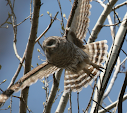Shortly after I arrived I scanned a large group of swallows on some hanging wires, it didn't take long to pick the one that was not like the others....

That is one white swallow...technically it is leucistic...a true albino would have the pink eye indicating a total lack of pigment.
The first notably leucistic bird I have found in the wild, and I did it all by myself! Ok, not that major of a feat when there are hundreds of birds all hanging out together and all in plain sight. What became more interesting was what I saw later....

Am I right, is this a partially leucistic Bullock's Oriole? I only have my Peterson Guide to Western Birds with me this morning, but I do not see anything else to match what I am seeing here.

Then to make a strange coincidence even more unlikely, I saw this bird at the far end of the lake.

I can't say for certain if they were or were not the same individual - although the first one appears to have more white where the Bullock's should have the black eye-band - but differences in time and light angle make it impossible to tell.

Am I right, is this a partially leucistic Bullock's Oriole? I only have my Peterson Guide to Western Birds with me this morning, but I do not see anything else to match what I am seeing here.

Then to make a strange coincidence even more unlikely, I saw this bird at the far end of the lake.

I can't say for certain if they were or were not the same individual - although the first one appears to have more white where the Bullock's should have the black eye-band - but differences in time and light angle make it impossible to tell.
Once again nature throws so many questions my way...
Do Bullock's Orioles go through a light molt? This young Oriole seems to suggest otherwise, but that one may have been further along....
If it (they) is (are) leucistic how uncommon would it be to have two in the same area? Are multiple leucistic individuals in the same brood possible? Common? Rare?
I don't think it likely, but can environmental factors increase the emergence of recessive genes?
Finally, am I just seeing these species because this is the season for hatches? Since I have really only been doing this since last October it is entirely possible that each summer hundreds of pale individuals are born, and then due to natural selection are weeded back out of the flocks by the time fall migration rolls around.
As always, if anyone has insight please feel free to comment or email me at daveabirding@gmail.com.



No comments:
Post a Comment